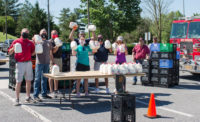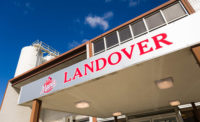
Minutes away from the nerve center of the nation is the nerve center of the Maryland & Virginia Milk Producers Cooperative Association, responsible for moving milk from parlor to pantry in a region extending from Pennsylvania to Alabama.
Established more than eight decades ago, the Reston, Va.-based milk producer and bottler takes pride in maximizing return to its members by maintaining a topnotch manufacturing infrastructure and marketing organization. Blessed with sales exceeding $530 million last year, Maryland & Virginia manufactures 410 SKUs, encompassing a full line of fluid products for its Marva Maid and Maola brands (as well as private labels like Giant Food), including milk, juice and drinks. In all, Maryland & Virginia processes nearly 60 million pounds of milk monthly for sale to consumers in the Baltimore/Washington, D.C., metro area, as well as the Carolinas and Virginias, plus Georgia, New Jersey and Delaware.
“We market 50% of our members’ milk through plants the association owns,” says Jay Bryant, chief executive officer and treasurer. “The other 50% we market to national or regional Class 1 outlets.” Those outlets include “a national and regional who’s who,” Bryant says, among them Dean Foods, HP Hood and Harris Teeter.
But at the top of that list is Maryland & Virginia itself. “We’re our largest Class 1 customer,” Bryant notes of the key consideration behind the co-op’s most recent acquisition, the former Giant Food fluid processing plant in Landover, Md., in March 2006. Maryland & Virginia was already the exclusive milk supplier to that facility, so when Giant Food parent Royal Ahold put the plant up for sale, Bryant explains, “maintaining that outlet was a considerable consideration.”

Important investment
Maintaining the quality and operational efficiency of all its manufacturing facilities is constantly top of mind at Maryland & Virginia. In fact, the past several years have seen a constant program of upgrades to not only the Landover plant, but also locations in Newport News, Va. and New Bern, N.C.Just this year, Marva Maid Newport News received new process controls and four new milk silos. “A lot of it was upgrading old technology,” says Jan tenPas, director of finance and operations for Maryland & Virginia’s fluid operations. The Virginia facility also got nine new route trucks along with four new trailers, on top of the 20 trailers acquired in 2007; about half the business out of Newport News is direct-store delivery.
Meanwhile, down in New Bern, Maola Milk & Ice Cream was treated to 58 new route trucks and 30 trailers this year; 90 percent of operations here are DSD. “That’s close to 30% of the fleet – kind of a catch-up move,” tenPas explains.
And Marva Maid Landover got a new homogenizer and is in the midst of a process control system upgrade. “One of the reasons we like Landover is it was a well-kept plant,” tenPas says of the facility that Maryland & Virginia has operated for nearly three years.
Hand-held software is being upgraded at all plants, while Maola is getting new routing software. “We’re looking at that to improve efficiency, take out miles and better serve customers,” says Fred Calvert, chief operating officer for fluid operations.
Moves like that have helped Maryland & Virginia cope with the skyrocketing energy costs that have only recently begun to come down to more manageable levels. “It’s an ugly story,” Calvert says. “These fuel costs are impacting our suppliers and driving all the inputs up. We’ve talked with them about frequency of deliveries and other ways to keep costs down.”
For the first three quarters of 2008, tenPas says, Maryland & Virginia’s fuel costs were $1.1 million higher than the same period in 2007, much more than anticipated. “We missed it by a dollar a gallon,” he says.
Keeping trucks full is a good-sense way of stretching fuel dollars. “We’re as much a distribution company as a manufacturer,” tenPas says. “Anything we can haul to fill up a truck, we’ll haul. With 1,396 SKUs, including manufactured and purchased items, we’ll carry anything that makes sense.”
Another effort to help offset energy costs is buckling down on shrink system-wide. “We’ve been concentrating on reducing plant loss at all three plants,” Calvert says, noting the recent installation of loss-reduction software at Newport News. Further, the company switched from diesel-powered truck refrigeration units to cold plates on its newest trucks.
Rivaling fuel woes are historically volatile milk prices. As both a processor and a producer, Maryland & Virginia finds itself on both sides of the milk pricing argument. However, management is quick to note that the extreme volatility is good for no one. “The volatility is equally frustrating. It’s killer,” Calvert says.
TenPas adds: “And everyone is concerned about what it’s done to demand, driving costs so high people are drinking less milk. They really are concerned.”

Seeking a balance
That has put increased importance on coming up with new products and seeking out new channels in which to market them. “As more shippers go to supercenters, they’re taking away milk business from other venues. The plus side is drug stores,” Calvert says, noting those are among the new outlets the company is seeing for its products.And among those products, it’s not milk but tea that’s current booming “and moving up,” Calvert says, as is apple cider.
But packaging changes have helped milk, especially the move away from paper cartons toward plastic bottles, tenPas says. “We do a significant school business, working with them to get the soft-drink machines out,” he says.
Another opportunity lies in milk’s position among comfort foods, something folks tend to turn to more in soft economies, tenPas says. “People are staying home more. There’s an opportunity to provide good products at a good price,” he says.
And as consumer demand has increased for milk from cows not treated with artificial growth hormones, Maryland & Virginia has had to balance the needs of its members and its customers. “We have customers that want [rBST-free milk]. But some co-op members have a different view,” Calvert says. “We’re not interested in taking sides. We listen to our customers and try to give them what they’re looking for.”
Mike John, chief operating officer over milk marketing, notes that the company has customers for organic and rBST-free milk. “We also have customers that have not asked for rBST-free milk,” he says. “We have a sales team that’s second to none in serving our customers’ needs.”
Bryant interjects: “We’ve always felt the best way to take care of our members is to take care of our customers. That’s at the core of what we do.”
In fact, going that extra mile is one of the key selling points management says it uses against competitors. “I think we do that for our customers and for our plant operations,” Bryant says. “We need to be quicker, more nimble, react faster to do more things for our customers.”
Of the co-op’s total milk volume, 65% goes to Class 1 customers (including Maryland & Virginia’s own plants) and 25% is sold to Class 2 users, including prominent ice cream and yogurt manufacturers.
Maryland & Virginia does a brisk powder business as well, sold through Dairy America, but this sector has its ups and downs as well. “There was a big difference in 2007 versus 2008. We produced five times more nonfat powder in 2008 than we did in ’07,” John says.
That volatility is a stumbling block for the company moving any of its powder in the export market. “For us, it’s all the supply side. We run it strictly for balancing,” John says, explaining that Maryland & Virginia helps to balance several northeast and mid-eastern federal order areas. “You need to be more consistent for export.”
Where they live
Meanwhile, Maryland & Virginia markets its own brands, which date back several decades. While Marva Maid and Maola hold their own against other regional labels sold at supermarkets and club stores, it’s private label that presents a force to be reckoned with, Calvert says. “It leads the market, whether we like it or not,” he says. “Marva Maid is the price leader, but the private labels set the tone.”Maryland & Virginia’s brand images are built around their geography and farmer ownership. “The idea that we’re local, we’re regional. We’re run from here and not somewhere else. We all live here,” Calvert says. “We’ve done radio and billboard, several years ago some TV. We participate in community events, the fun stuff. Our salespeople are out there among our customers in the community, just trying to be a part of any function we can be.”
That visibility, in major population centers from the Mid-Atlantic to the Southeast, will be important to Maryland & Virginia’s continued success, as well as looking beyond. “We live in the heart of that market – that has challenges and opportunities,” Bryant says. “To continue to stay strong financially, to grow our value-added commercial business, being involved outside our traditional regions is something we’ll have to be open to. You have to be prepared for opportunities that may come.”
Those opportunities are expected as the company looks ahead to the next five years. “We’ll continue to grow our fluid business and I think we’re going to be in other regions as we continue to grow our membership base,” Bryant says.
Moving the organization forward will be what the executives say is Maryland & Virginia’s most unique aspect: a team-based management style. “It’s a collaborative group of people that come to a consensus after challenging each other,” says Jorge Gonzalez, chief financial officer, “It’s a very in-depth team approach. Everyone speaks their mind.”
John agrees: “It’s truly a family situation. We don’t always agree, but we know the ultimate goal is to serve our members, and we get there.”
The management team enjoys the full backing of the farmer owners. “They understand and respect the fact that we’ve brought together a diverse group of people to get different opinions,” Bryant says. “They seem to have confidence in our management team and are very optimistic about where we’re going.”
And that’s particularly important right now. “We’re financially healthy, performing well and prepared to deal with difficult times,” Gonzalez says, “in a way that provides service to our members and customers.”
History
Maryland & Virginia Milk Producers Cooperative Association Inc. began in 1920 thanks to a determined group of dairy farmers seeking to more successfully market their milk in the Washington, D.C., metropolitan area. Today, Maryland & Virginia is a milk marketing cooperative owned and operated by nearly 1,500 dairy farm families from Pennsylvania to Alabama, including those brought into the fold after a merger with the Carolina Virginia Milk Producers in 1999.Member farms vary in size and shape, some with herds fewer than 100 cows and others more than 2,000 head. Maryland & Virginia members together produce 3 billion pounds of milk annually, equal to more than 175 tanker truck loads of milk each day, processed daily into high-quality milk and dairy products. Member milk serves major metropolitan areas including Baltimore; Washington, D.C.; Richmond, Va.; Charlotte, N.C.; and Atlanta.
Based in Reston, Va., Maryland & Virginia’s milk marketing and value-added businesses work to fulfill the cooperative’s mission to maximize member returns. From branded fluid milk to commercial ingredients like cream and high-heat powder, Maryland & Virginia products represent an important sector of America’s food chain.
The cooperative markets member milk throughout the Mid-Atlantic and Southeast regions. In addition, Maryland & Virginia owns and operates three fluid processing plants: Marva Maid of Landover, Md.; Marva Maid in Newport News, Va.; and Maola Milk & Ice Cream in New Bern, N.C.; plus a manufacturing plant in Laurel, Md., and a farm supply warehouse in Frederick, Md. The company also owns a majority interest in Valley Milk Products LLC, a manufacturing plant in Strasburg, Va.
In March 2006, Marva Maid of Landover became the newest member of Maryland & Virginia’s processing family. This plant, acquired from Giant Food LLC, can process up to 32 million pounds of milk each month, in addition to bottled water and fruit drinks. The Landover plant continues to serve Giant Food exclusively; its products are sold in nearly 200 supermarkets in Maryland, Delaware, Washington, D.C., and northern Virginia.
Processing a complete line of fluid milk products, Marva Maid of Newport News has been a profitable part of the Maryland & Virginia family of businesses since 1962. The plant can process more than 25 million pounds of milk monthly and supplies retail stores throughout Maryland, Virginia and West Virginia. Marva Maid continues to be the top milk supplier in the region and was a leader in developing the new look of school milk. The plant supplies milk and ice cream to U.S. military bases in Virginia and abroad.
Acquired in January 2003, Maola Milk & Ice Cream in New Bern, N.C., processes and packages fluid milk, juice and other products for consumers in North Carolina, South Carolina and Virginia. The plant can process up to 20 million pounds of milk each month, producing 100,000 gallons of milk per day and selling 1.5 million gallons of ice cream annually. Founded in 1935, Maola employs nearly 400 people at New Bern and 13 distribution centers in the southeast.
Butter, condensed milk and nonfat dry milk powder are produced at the member-owned manufacturing plant in Laurel, Md. These ingredients are marketed to food companies that manufacture products such as infant formula, ice cream, candy and bakery items. Serving as a regional balancing plant since 1955, Laurel processes between 25 million and 110 million pounds of milk each month, depending on the seasonal supply of milk.
Valley Milk Products LLC, a partnership between Maryland & Virginia and Don Utz, is a balancing plant in Strasburg, Va., that complements the Laurel facility. Supplying a variety of customers in the eastern third of the country, Valley Milk can process more than 200 million pounds of milk each year in the form of cream, butter, dried milk powder and condensed milks.
SOURCE:www.mdvamilk.com.
The Maryland & Virginia Family of Products
In addition to the retail clients it serves, the Maryland & Virginia Milk Producers Cooperative Association maintains two dairy product brands of its own.The Marva Maid brand originated in the 1960s and offers a full line of fluid dairy products, including white and flavored milk, buttermilk, eggnog and orange juice, in various container sizes ranging from 8 ounces to 1 gallon.
Marva Maid products are distributed throughout the Hampton Roads, Richmond, Northern Virginia and Eastern North Carolina communities.
Acquired by Maryland & Virginia in 2003, Maola Milk & Ice Cream Co. has made high-quality milk and premium ice cream since 1935. The brand has a strong reputation for producing top-quality dairy products.
The Maola brand and product line features 48 flavors of ice cream, 33 varieties of milk and five kinds of ice cream novelties. Maola-branded products are distributed throughout North Carolina and in parts of South Carolina and Virginia.


